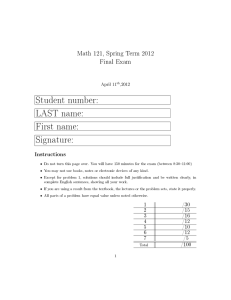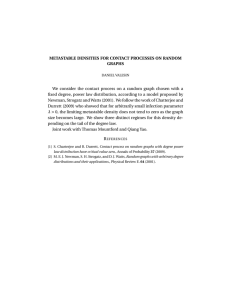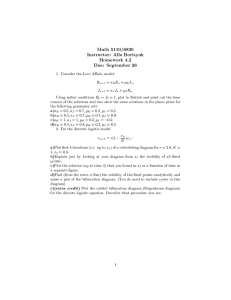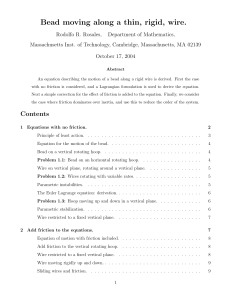18.385j/2.036j
advertisement
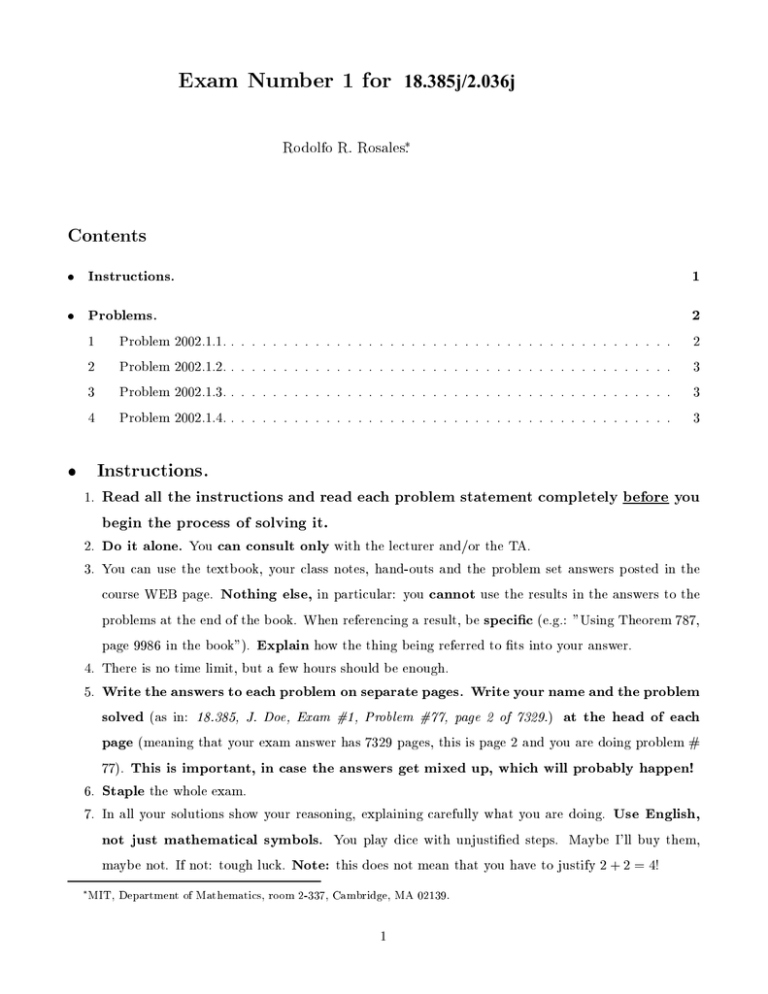
Exam Numb er 1 for 18.385j/2.036j Rodolfo R. Rosales. Contents Instructions. 1 Problems. 2 1 2 3 4 Problem 2002.1.1. . Problem 2002.1.2. . Problem 2002.1.3. . Problem 2002.1.4. . . . . . . . . . . . . . . . . . . . . . . . . . . . . . . . . . . . . . . . . . . . . . . . . . . . . . . . . . . . . . . . . . . . . . . . . . . . . . . . . . . . . . . . . . . . . . . . . . . . . . . . . . . . . . . . . . . . . . . . . . . . . . . . . . . . . . . . . . . . . . . . . . . . . . . . . . . . . . . . . . . . . . 2 3 3 3 Instructions. 1. Read all the instructions and read each problem statement completely before you begin the process of solving it. 2. Do it alone. You can consult only with the lecturer and/or the TA. 3. You can use the textbook, your class notes, hand-outs and the problem set answers posted in the course WEB page. Nothing else, in particular: you cannot use the results in the answers to the problems at the end of the book. When referencing a result, be specic (e.g.: "Using Theorem 787, page 9986 in the book"). Explain how the thing being referred to ts into your answer. 4. There is no time limit, but a few hours should be enough. 5. Write the answers to each problem on separate pages. Write your name and the problem solved (as in: 18.385, J. Doe, Exam #1, Problem #77, page 2 of 7329.) at the head of each page (meaning that your exam answer has 7329 pages, this is page 2 and you are doing problem # 77). This is important, in case the answers get mixed up, which will probably happen! 6. Staple the whole exam. 7. In all your solutions show your reasoning, explaining carefully what you are doing. Use English, not just mathematical symbols. You play dice with unjustied steps. Maybe I'll buy them, maybe not. If not: tough luck. Note: this does not mean that you have to justify 2 + 2 = 4! MIT, Department of Mathematics, room 2-337, Cambridge, MA 02139. 1 18.385j/2.036j Exam # 1. (Rosales). 2 IMPORTANT POINT: a computer plot is not enough! For example, in cases where a phase plane portrait, or classication of critical points, or something like this is required, an explanation and justication of your conclusions is expected. The computer should be taken merely as a way to produce a pretty plot, give you hints as to what might be going on, check out your ideas and so. I have no interest in testing your ability to use PHPLdemoB or equivalent software! At any rate, beware: some of the problems may have subtleties that are easy to gure out with a good analysis, but can fool you in a computer plot (if you do not know what to look for). Please: no "chicken scratches" or arrows on the side of the page leading from one piece of an argument to another and so on. If a particular thing is illegible, write it again. The answers MUST be readable. 8. Start early. Do not wait till the night before it is due. 9. By the way: you are not expected to produce answers at the level of the ones provided in the web page; you are, however, expected to read them. Problems. I will be looking for REAL arguments. I do not require, nor expect mathematical rigor, but do expect what may be called a "reasonable person" justication of your conclusions | of the type used in both the lectures, the notes on the WEB page, and the answers to the problem sets provided. Note: 1 Problem 2002.1.1. Statement: Consider the equation d2 x where 0 < 1. Using a stability] for this equation. dt2 two-timing cos(x) dx +x = 0; dt (1.1) approach, calculate (to leading order) the limit cycles [and their Hint 1.1 In this particular example it is convenient to write the leading order solution in the form x0 = a( ) cos(t), where is the slow time and the origin of time is selected so that there is no sine term. What you are being asked to do is to nd an equation for the amplitude a = a( ). In this endeavor you may want to check the integral representations for the integer order Bessel functions. 18.385j/2.036j Exam # 1. (Rosales). 3 Note 1.1 This problem is worth 25 points. 2 Problem 2002.1.2. Statement: Do problem 3.5.4 in the book by Strogatz [bead on an horizontal wire]. Note 2.1 This problem is worth 25 points. 3 Problem 2002.1.3. Statement: Consider problem 3.5.4 in the book by Strogatz [bead on an horizontal wire], and change it as follows: Assume that the relaxed length of the spring L, is much smaller than the distance h from the spring support to the wire. That is L h. Thus you can make the approximation L = 0 and eliminate a parameter from the problem. Assume that the whole contraption is rotating, at angular velocity , around a vertical axis going through the support of the spring. Note 3.1 This problem is worth 25 points. 4 Problem 2002.1.4. Statement: Do problem 3.6.6 in the book by Strogatz [patterns in uids]. Note 4.1 This problem is worth 25 points. THE END.


